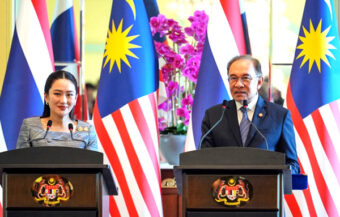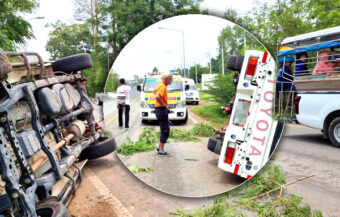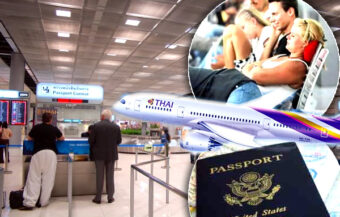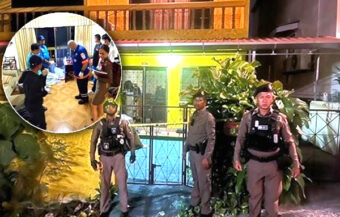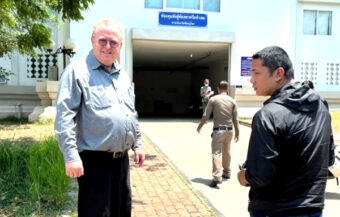Thailand was hit by two minor earthquakes on Monday, a 1.4 magnitude tremor in Chiang Mai and a 3.5 magnitude in Krabi. Despite this, the country continued to celebrate Songkran. Prime Minister Paetongtarn Shinawatra and family joined festivities in Chiang Mai.
Thailand was struck with two earthquakes on Monday, beginning with a 1.4 magnitude early morning strike in Chiang Mai followed by a more serious 3.5 magnitude in Krabi in the afternoon. However, these did not dent the country’s popular New Year nationwide celebrations for Songkran. Prime Minister Paetongtarn Shinawatra celebrated in Chiang Mai with friends and family.

Thailand has been struck by two earthquakes on Monday. Certainly, the most significant was on Monday afternoon at 2:27 PM, when a 3.5 magnitude tremor hit the Nuea Khlong district of Krabi in southern Thailand. In particular, the quake struck the Khlong Khem sub-district, which was where the epicentre was located.
At the same time, the quake tremors also shook the Muang district of the popular holiday province.
According to the Earthquake Watch Division of the Meteorological Department, the quake had a shallow depth of only 2 kilometres, making it more easily felt by residents.
Earthquake tremors lead to evacuations and structural checks across Krabi following 3.5 magnitude quake
The epicentre was recorded at latitude 8.022 degrees north and longitude 98.978 degrees east. Local authorities reported that tremors were most prominently felt in Nuea Khlong and Mueang districts.
The tremors were felt throughout the province and led to the evacuation of a local government office. Later, this was reported as the City Hall building in the centre of Krabi. Several other government offices were also evacuated.
Initial responses from the Krabi Disaster Prevention and Mitigation Office indicated moderate shaking was felt in key public buildings including Krabi Airport and Krabi Hospital.
While there was no initial damage reported, all structures were later placed under inspection as a precaution. Officials emphasised that teams were continuing to monitor the situation for aftershocks or structural concerns.
More sub-districts confirm quake effects but no damage or injuries were reported from Monday afternoon tremor
Afterwards, at 3:20 PM, the Krabi Disaster Prevention and Mitigation Office confirmed that the Pakasai Sub-district, Taling Chan Sub-district, Khlong Khem Sub-district, and Nuea Khlong Sub-district all felt the quake. However, there were no reports of injuries or damage.
Reports state the epicentre was in the Khlong Khem sub-district of the Nuea Khlong district. The latitude was 8.022 degrees north, longitude 98.978 degrees east. The quake, with a magnitude of 3.5, caused vibrations and rumblings.
A report approximately 8.8 km from the epicentre suggested the intensity lasted only a few seconds. “Strange feeling. I was crossing a road in Krabi town. It was a sound of detonation and a short movement of the ground. Very strange. I’m glad that it was just one time and that nothing bad happened.”
At the same time, someone outside at Krabi Boat Lagoon Marina reported moderate shaking and horizontal swaying. This person was 2.2 km from the epicentre. “Grumbling, thunder-like noise, followed by horizontal shaking, the duration was 3–5 seconds.”
Thai witnesses report noise and short swaying movement during Monday’s Krabi earthquake event
This was confirmed by Thai eyewitness accounts. Some suggested the quake lasted as long as 10 seconds, while others observed it for 5–7 seconds.
Some video from Krabi shows swaying signs and buildings shaking even at ground level. Families came out to inquire about what was happening.
Earlier on Monday, Thailand also felt the impact of a 5.3-magnitude earthquake in Myanmar. This was centred approximately 10 km from the Thai border, striking at a depth of 10 km. This was at 3:02 AM.
Additionally, the Earthquake Observation Division reported that a magnitude 1.4 earthquake also occurred in the Phrao district of Chiang Mai at 12:04 AM the same day, with a depth of 1 km.
Though minor, some residents in the area reported subtle tremors, especially those who were in bed at the time. It was not widely felt or reported outside the district.
Recent tremors felt in Thailand include border and Chiang Mai events with mild overnight disturbances
Previously, on Sunday, areas of Thailand also felt tremors from a 5.5 magnitude earthquake in Myanmar. This was centred in Meiktila in the Mandalay region.
The news comes as Thailand is still on edge since the March 28th earthquake in Burma, which caused significant tremors in the Thai capital, Bangkok. Afterwards, 55 significant buildings were closed as a result of the earthquake, while hundreds of buildings suffered damage.
The March 28 event was a seismic wake-up call. Despite the epicentre lying across the border, the quake rattled a wide area, with notable concern over building safety and future preparedness.
The earthquake has also damaged confidence in the construction of high-rise condominiums in Bangkok. Furthermore, it has caused substantial booking cancellations for nervous tourists planning to travel to Thailand. Many had booked hotels in Bangkok, which are predominantly high-rise buildings.
March 28 quake in Burma caused widespread Bangkok disruption damaging tourism and housing confidence
The collapse of a 30-storey state building understood to be under construction also made headline news across the world.
Substantially, this building collapse has been the subject of criminal inquiries into the contractors involved. In particular, there is concern over the quality of materials used in the building and its engineering bona fides.
Authorities investigating the collapse have begun examining whether the earthquake exacerbated structural flaws already present in the building’s design and construction.
Public concerns have mounted amid fears about oversight and regulation in the country’s growing high-rise construction sector.
The incident on March 28th and the ensuing instability are causes of concern. Indeed, for Thailand, it is unprecedented.
Meanwhile, authorities are urging calm. For safety, most buildings in Bangkok and the kingdom were re-analysed after the March 28th quake. At the same time, Thailand itself has been the subject of quakes such as in 1935 and 1956. These later gave impetus to revised building standards.
Concerns rise over oversight as state tower collapse highlights deepening fears after Bangkok quake
Indeed, Thailand is presently home to no fewer than 16 active faults across the kingdom. Most of these are in northern Thailand, but they also extend along its western border with Myanmar and into the south.
These include major fault groups such as the Mae Chan, Si Sawat, Mae Lao, and Ranong faults, each capable of generating damaging quakes.
For example, the Mae Lao Fault was responsible for a 6.3-magnitude quake in 2014 in Chiang Rai, which caused widespread damage. The Ranong Fault, which runs through southern provinces including Phang Nga and Prachuap Khiri Khan, is especially relevant due to its proximity to Krabi and the Andaman coast.
The Department of Mineral Resources and the Meteorological Department have long highlighted the seismic potential posed by these fault lines. Geological studies have shown many of them have produced powerful earthquakes in the past and could do so again.
Fault lines across Thailand remain a threat with southern and northern regions vulnerable to tremors
Despite its reputation as a relatively low-risk seismic zone, Thailand’s geographical positioning near the collision zone of the Indian and Eurasian tectonic plates means the risk cannot be ignored. As events in recent weeks have shown, tremors can strike across multiple regions—from Chiang Mai to Krabi—highlighting the importance of preparation, updated building standards, and public awareness.
Notably, these earthquakes in Thailand on Tuesday are not impacting the country’s psyche. For example, the only thunder being heard on Thai streets presently is the heat rain storms or music beat boxes as people party and play water games. The kingdom is in the midst of its Songkran celebrations.
Songkran is underway all over Thailand but particularly in Bangkok for water play and a PM in the sky
Tourism minister orders all Bangkok hotels surveyed as this Friday’s shocking Earthquake fallout mounts
For a country embattled by earthquake fears and looming tariff threats from the United States, the atmosphere in Thailand is one of a nationwide party.
On Monday, Prime Minister Paetongtarn Shinawatra was in Chiang Mai with her family and father, the ex-Prime Minister. Over the weekend, Mr Thaksin urged Thais to find spirit in uniting for this year’s New Year celebrations for Songkran.
Join the Thai News forum, follow Thai Examiner on Facebook here
Receive all our stories as they come out on Telegram here
Follow Thai Examiner here
Further reading:
Songkran underway all over Thailand but particularly in Bangkok for water play and a PM in the sky
Songkran in full swing as Thailand prepares to welcome back long-haul visitors in large numbers
14 days quarantine confirmed for all passengers from high risk listed countries and now in place
Tourism minister predicts higher temperatures will help to bring an end to the coronavirus threat



